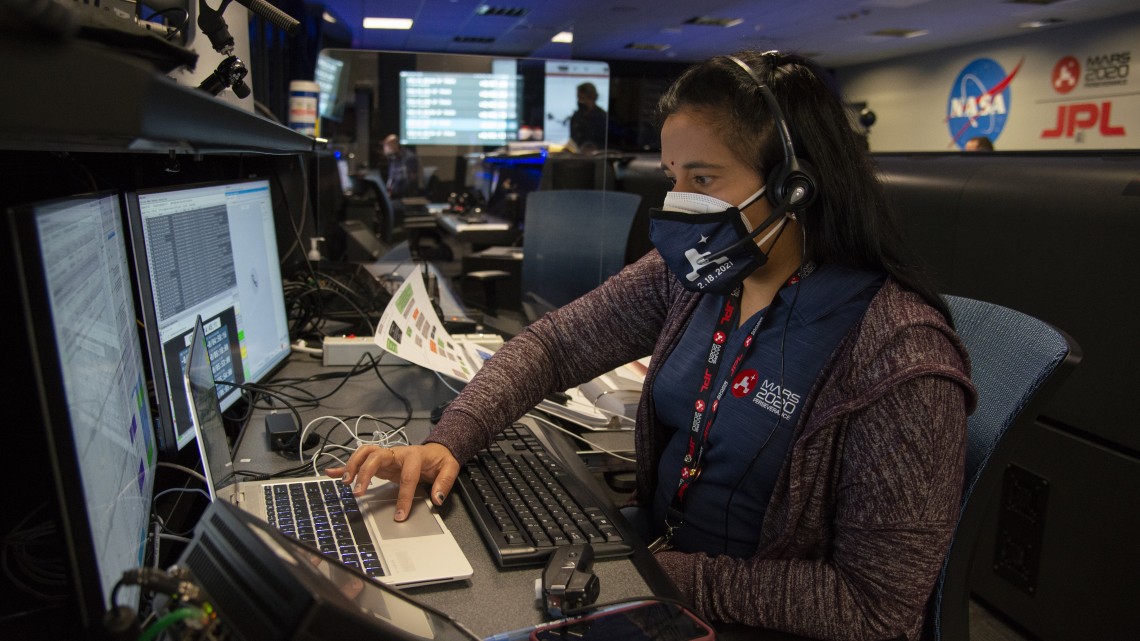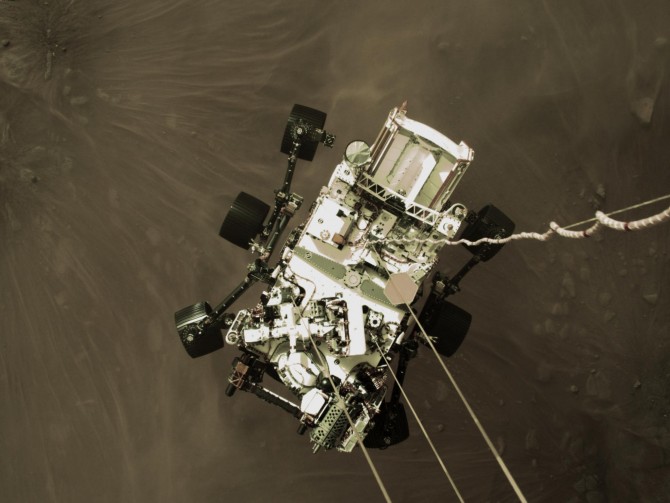
Swati Mohan '04 at NASA's Jet Propulsion Laboratory mission control on Feb. 18, prior to the Perseverance landing.
After landing Mars rover, Mohan ’04 reflects on time at Cornell
By Erin Philipson
For Swati Mohan ’04, curiosity about space exploration began with Star Trek.
“I remember seeing the images of the far reaches of the galaxy,” Mohan said, “and the premise that they had put this together in this part of space was really mind boggling. The rules were different, and different things could happen. That sparked my interest.”
On Feb. 18, Mohan, a graduate of the Sibley School of Mechanical and Aerospace Engineering, narrated the historic landing of the NASA Perseverance rover on Mars after a 292.5 million-mile journey.
“Touchdown confirmed,” Mohan said, speaking from mission control at NASA’s Jet Propulsion Laboratory (JPL) in southern California. “Perseverance is safely on the surface of Mars, ready to begin seeking the signs of past life.”
Mohan had worked on the Perseverance team since 2013, when the mission began. She was among a number of Cornell alumni at mission control including Aaron Stehura ’09, M.Eng. ’10, Kevin Lo ’13, M.Eng. ’14, and Nagin Cox ’86.
Mohan was the mission’s guidance, navigation and controls operations lead, essentially the eyes and ears of the spacecraft on its seven-month, 300 million-mile cruise to Earth’s neighboring planet.
She chose to attend Cornell because of its many connections to space research, such as the Arecibo Observatory, the recently decommissioned radio telescope in Puerto Rico that was conceived by Cornell faculty, built with federal funding and then managed by Cornell for its first five decades. She was also interested in the work of Steve Squyres ’78, Ph.D. ’81, professor emeritus of astronomy in the College of Arts and Sciences, with the Mars Pathfinder mission.
As an undergraduate, Mohan conducted research with Mark Campbell, the John A. Mellowes ’60 Professor in Mechanical Engineering, on the CubeSat satellite project. Campbell assigned Mohan to the attitude controls system, the same sub system she works on to this day.
“That one assignment helped me find my niche that I've continued in throughout my career so far,” Mohan said.
Campbell was an influential mentor for Mohan during her undergraduate career, not just in the lab but also in the satellite design class he taught. After graduating a semester early and working at JPL for a year, Mohan joined the Massachusetts Institute of Technology Space Systems lab for her graduate degree - the same lab in which Campbell completed his doctorate.
“Swati always had this amazing passion for space. She loved each and every aspect, from the news to internships to classes to our student satellite projects,” Campbell said. “When you combine that passion with her excellent technical, collaborative and leadership abilities, it is not hard to see how Swati has become the impactful engineer and leader she is today.”
While at JPL, Mohan worked on NASA’s Cassini just as the sophisticated robotic spacecraft took its first images of Saturn. The mission studied Saturn and its complex system of rings and moons.
“Here was a project that had been formulated the year I was born, in 1982, and had launched in 1997, when I was still in high school,” Mohan said, “and the timing just worked out that I got to be there working on it when it reached Saturn and took its first images, which was really cool.”
The days leading up to the landing were filled with nerves, causing the JPL team to check and recheck everything, according to Mohan. But the mission proved successful, beginning a multi-year, multi-mission campaign to bring samples from Mars back to Earth.
Information from the Mars Reconnaissance Orbiter showed that the rover landed within 5 meters of the point they had chosen, well within JPL’s goal of landing at least 60 meters from the targeted location.
“As you're coming down, it's basically like saying, ‘which is the best house for me to go to,’ finding that house and then landing in the bedroom,” said Mohan. “To go all the way from Earth to Mars and land within 5 meters of where we picked is just phenomenal.”
Mohan’s primary research while pursuing her graduate degrees was a testbed called SPHERES, which is a set of three satellites that are on the International Space Station. Within about a month of starting at MIT, she got word that the satellites were going to be launched.
“It was just a really cool experience of being able to have this platform where you can take something all the way through,” said Mohan. “I could conceive of an algorithm, code it, test it on the ground, link it into space, test it in space, and then get the data back. Then with the data I got back, I could improve for the next round.”
Mohan’s advice for current students is to just keep trying. “What I learned most from Mars 2020 is not from that one landing day, it's from the eight years spent working on the project and coming across failures, both small and big, and having to persevere through all of those to get to that next step.”
Erin Philipson is a communications specialist for the Department of Earth and Atmospheric Sciences.
Media Contact
Get Cornell news delivered right to your inbox.
Subscribe

